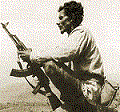The Dhofar

By July 1970, the province of Dhofar in western Oman was almost entirely in the hands of Communist-backed rebels belonging to the Popular Front for the Liberation of the Occupied Arabian Gulf (PFLOAG). The Sultan of Oman had failed to recognise the danger and had done little to gain support among the indigenous people of Dhofar. The province was ideal guerrilla country, being dominated by a range of mountains in which the Sultan's Armed Forces found it difficult to operate. On 23rd July, the Sultan's son Qaboos bin Said, seized power in a palace coup to try and save his inheritance. He immediately introduced policies based on British counter-insurgency operations (COIN) and new government agencies were set up, designed to modernize Oman and persuade the ordinary people that the Sultan was worth supporting. Elements of 22 SAS were sent to help the expanded SAF defeat the PFLOAG.

The repression of the Dhofar people by the previous Sultan caused them to form the Dhofar Liberation Front. When the SAS were deployed to Oman in the early 1970s they embarked on a hearts and minds campaign to win the Dhofaris back to the new Sultan. The DLF was mainly poorly armed and equipped, but some of their soldiers had fought with other Arab armies. Another group in Yemen, The PFLOAG (Adoo) were faring a little better with supplies by the Communist Chinese and Soviet Union and made an offer to the DLF to amalgamate to share their fight. The DLF agreed to the offer after much discussion and the PFLOAG soon spread its influence through the Jebel Dhofar, controlling the tribes-people with threats. The proud Dhofaris resented the arrogance and dominance of the PFLOAG and began to fight back. The PFLOAG ordered their disarmament and this led to many battles between the two organizations. The SAS exploited this spilt in their hearts and minds campaign, persuading many of the Dhofari guerrillas to surrender to the government under the new Sultan. Many of these Dhofaris joined the Firqat troops under BATT command.



